Organizational recovery from the COVID-19 pandemic is not linear—there is no one moment when all organizations, or all communities, can declare it truly over. Given this enduring nature of COVID-19 and its effects worldwide, many professional accountancy organizations (PAOs) may be in crisis management mode. In addressing previous and current adversity though, the global accountancy profession has not only remained steadfast and committed, but it has also adapted for members’ and society’s benefit. Likewise, there is opportunity to continue championing adaptability and take the lessons from 2020 forward into strategic planning and development.
Strategy and planning that address recovery and reimagine the role of the association and profession are crucial. This will help PAOs navigate future crises, including natural disaster, security risk, and/or another health crisis. All of these could lead to no or limited access to the office, business shutdowns, connectivity disruptions, limited gatherings, etc.
Because recovery is not the same for all organizations, a one-size-fits-all approach will not work for IFAC’s diverse, global membership. However, there are common concerns that are interconnected for all PAOs, regardless of size and location, such as:
- Operational resilience: Operational resilience is an organization’s ability to adapt to changing environments. This includes the resilience of systems and processes – such as strategic planning, governance, and day-to-day operations.
- Financial strategies for resilience: No strategy or operation can be properly executed without understanding your financial capacity and, for membership organizations, revenue streams and diversification is a consistent challenge.
- Education: Aside from membership fees, education—through initial programming, examinations, and continuing professional development—often makes up a significant portion of PAOs’ revenues. There are opportunities to diversify with specialized, targeted certifications and offering business-to-business trainings, depending on your market needs.
- Information Technology: Education and operations will continue to be shaped by digitalization. Digitalization must be integrated into a PAO’s strategy. It is also essential for business continuity and resiliency—for example, some digitalization must take place before another crisis, such as moving working documents to a secure cloud to allow remote access.
- Communications: All activities and actions that a PAO takes should be informed through the regular communications it has with its membership, staff, and key stakeholders to ensure the PAO is demonstrating its relevancy, responsiveness, and value-add.
Image
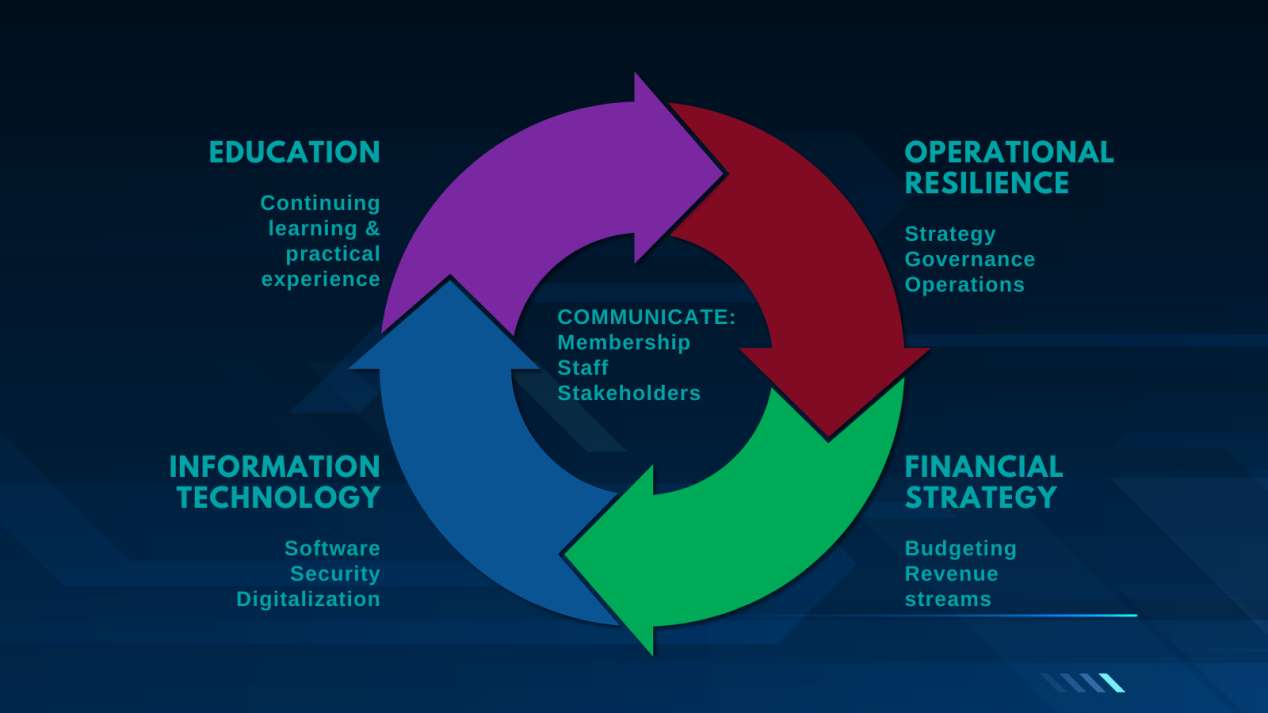
Image

No matter where your PAO falls within the Respond, Recover, Reimagine spectrum, these areas are relevant, although your objectives and the questions your organization asks itself will naturally differ. IFAC’s PAO Development & Advisory Group has created a frame of reference to help PAOs in strategic discussions with leadership, governance, and management to determine next steps. The prompts will not provide all the answers or information you may need for your context; rather, they can drive scalable input and ideas. This page also includes collated resources from across IFAC’s network.
-
Operational Resilience
Consider these prompts when planning for your PAO's future.
Day-to-Day Operations:
- As part of your response and recovery, what safety measures are needed? Will you need reduced on-site employees, distancing, protective equipment, training?
- How often are you updating staff? How are you addressing their needs and perspective?
- Consider the format in which information is being communicated to staff i.e., memos, virtual meetings, WhatsApp group chats. How effective has this communication been thus far? What improvements can be made?
- As you reimagine talent recruitment and retention, how will you move to a more permanent remote or flexible working models?
- Will the ability to work virtually and technology knowledge/competencies be a greater part of the hiring process for your PAO?
- Has your PAO considered cost saving measures in your day-to-day operations such as the re-location of or closing branch offices?
- To prepare for another disruptive event, what needs to be in place in case the office is inaccessible again? Consider having pre-emptive conversations about disaster planning, including evacuation, and explore available resources.
Governance
- Evaluate your board and council capabilities to close any gaps between management and volunteers: Do your volunteers understand your PAO’s pressures? If you need to respond to a future crisis, do you have a business continuity plan in place?
- Evaluate communication and meeting frequency during response and recovery:
- How regularly does your CEO speak to or brief your board and/or council?
- How does your CEO present information to the board and/or council? Consider style of communication and presentation mode (e.g., papers, a video, etc.).
- When planning future meetings especially if virtual, consider the length of time of board and council meetings. What matters can be addressed via email to shorten meeting times for maximum effectiveness and active participation?
- Evaluate response, recovery, and reimagination needs and ability to:
- Continue elections and your annual general assembly (AGM) virtually: Would your organization benefit from increased participation if a virtual approach were adopted long term? Consider asking for feedback from members about 2020 AGMs.
- Maintain and strengthen your volunteer power:
- Would your organization benefit from a wider pool of volunteers if a hybrid approach to meetings was adopted long term?
- How are you encouraging current members to progress in board positions (where applicable)?
- How are you including younger professionals into the volunteer pipeline?
- How are you fostering diversity and inclusion in your governance structure and attracting and retaining volunteer talent?
Strategy
Serving as the guidepost for the whole organization, the strategic plan helps clarify your organization’s direction, purpose, and goals, and provides a platform to communicate with all key stakeholders.
- Has your PAO made any significant changes to its strategy because of the pandemic?
- What does your PAO stand for and what is its overall purpose? In the recovery and reimagine phases, your KPIs, priorities and activities should be proportionate to your PAO’s size and reflect what is relevant and achievable in your national context.
- What is the right planning horizon for your PAO? For example, is it a 1–2-year strategic plan better suited than a traditional 5-year plan?
- A SWOT analysis may be used to identify the Strengths, Weaknesses, Opportunities and Threats to achieving your PAO’s objectives: Has your PAO done a SWOT analysis? Does it need to be re-evaluated or updated? Consider whether an external expert is needed to facilitate a strategic planning session.
- Scenario planning is another decision-making tool designed to help identify, assess, and formulate timelines and plans to adapt to risk and uncertainty. PAOs will need to communicate well with staff, members, leadership, and other key stakeholders to get a diverse range of perspectives on the future.
- What are your membership’s current needs? How are you incorporating their perspective into strategic planning as a critical force for your PAO? Consider convening a regular webinar/workshop to hear directly from them.
-
Financial Strategy
Consider these prompts when planning for your PAO's future.
- Is your budgeting and forecasting cycle clearly defined?
- How is your budget aligned with your strategy?
- Ensure you have accessible information for your business core activities, which speaks to ICT and information systems: Do you have centralized sources for reviewing membership renewals and subscriptions? Continued professional development registration?
- Review and analyze your income. Has income decreased or increased, especially over the last year? What trends do you see? How can use this data to enhance your PAO’s financial viability?
- Are you offering or continuing to offer membership payment plans?
- Do you offer mobile or online payments for member convenience?
- Does your PAO have concentration risk i.e., are you too reliant upon a single area for revenue or are the PAO’s investment centered in one area? If yes, how do you manage it? Are there plans to consider diversification of revenue? For example, see the Education section below—have you considered the needs of the public sector?
- Do you have professional indemnity directors’ and officers’ insurance coverage? Is this appropriate for your PAO? What other insurance does your PAO need?
- What is your procurement process and supply chain process? Is it stable?
- Are you engaging with your government to access government incentives and grants? Are you aware of your government initiatives your PAO could benefit from? Have you developed a plan to effectively take advantage of them?
- Would outsourcing and partnering with others to efficiently access financial software tools be beneficial to your organization?
- How are you managing the relationship with your banking institutions? Is your PAO in a position to negotiate with the banks for long-term credit facilities?
- In the event of another crisis, do you know your cash flows? What are your reserves? Have you assessed your risks? Do you have enough reserves to sustain a future crisis, system failure or sudden loss of membership?
-
Education
Consider these prompts when planning for your PAO's future.
- How are your exams structured? Are they offered in-person or online? Are your testing sites accessible and safe? Learn from other IFAC members who made the transition to offering examinations online in a short period of time.
- Have you explored how the IFAC Accountancy Education E-Tool can assist your PAO’s continuing efforts to follow internationally accepted principles? The e-tool, which is grounded in the International Education Standards, is a comprehensive tool that links the standards and practical implementation support.
- Is your PAO providing the right education and development for members right now and for the future? Have you considered the soft skills and competencies members need to provide the best quality of services?
- Have you engaged with your government, including your ministry of education? Business leaders to gauge what competencies are needed in the workplace?
- How is your PAO reimagining its membership attraction and retention? Are there opportunities to enhance the pathway into the profession for individuals from other fields or those exploring second careers? Do you have partnerships with tertiary providers? Universities?
- How do the public and potential students know about your educational programs and qualifications? Have you considered a marketing campaign?
- Have you identified the education stakeholders in your jurisdiction? Should you partner with an independent education provider, university, or other service provider?
- Have you considered the education and professionalization needs of the public sector and the role your PAO can play?
-
Information Technology
Consider these prompts when planning for your PAO's future.
- Take advantage of IFAC’s PAO Digital Transformation Series and the free Digital Readiness Assessment Tool to assess your PAO’s digital readiness, and the next steps on your digital journey.
- Evaluate if your PAO’s digital strategy is linked to your overall strategy: How is the software, platform, and other elements you select connected to your strategy and goals? For example, what stakeholders do you need to be able to communicate with the fastest? Consider your membership, students, regulators.
- Be prepared to respond to the next crisis: have you moved documents from paper to a secure cloud-based technology? Accessible in case people must work remotely?
- Conduct a scenario planning analysis – what if the system goes down?
- How are you engaging and learning from other PAOs and stakeholders on best practices to enhance your IT strategy and capabilities?
Strategic planning videos
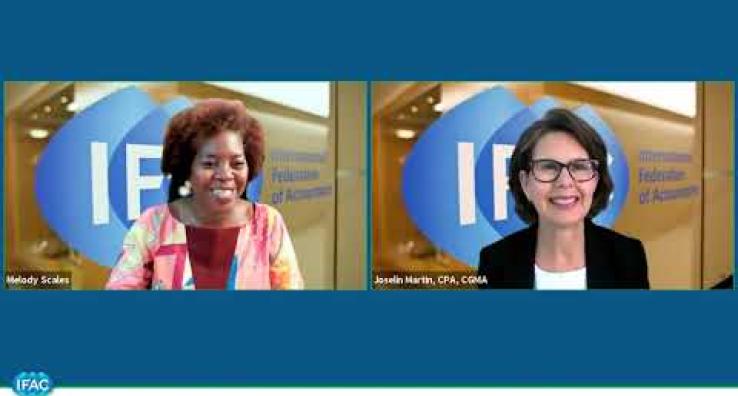
Building Resilience & Value in Uncertain Times: Why is Strategic Planning Essential?
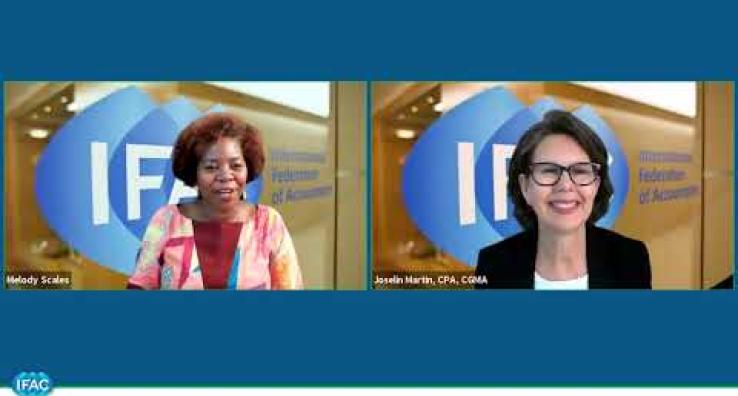
Building Resilience & Value during Uncertain Times: Strategic Planning 101
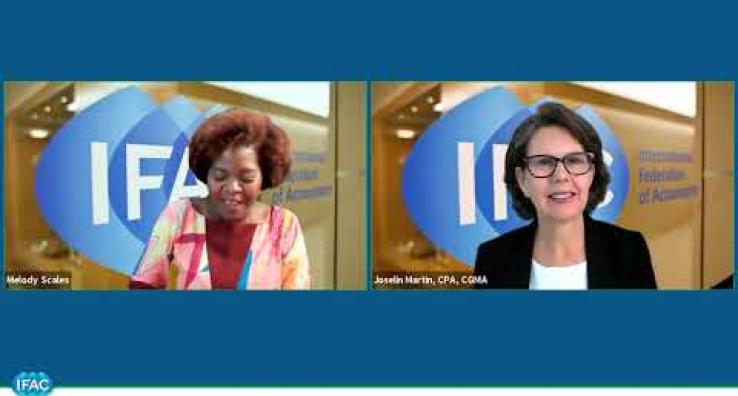
Building Resilience & Value during Uncertain Times: Trends in Strategic Planning
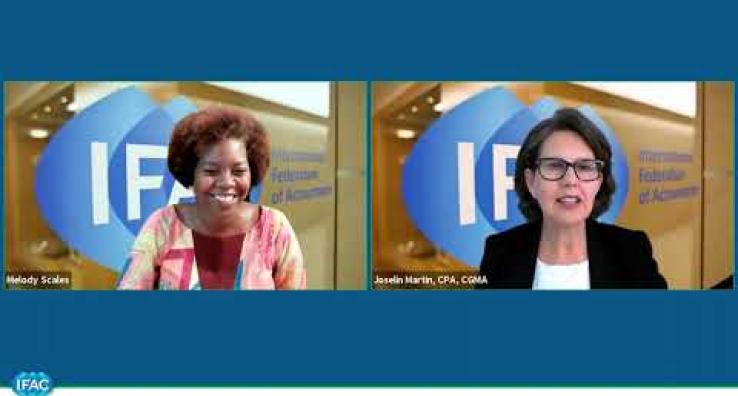
Building Resilience & Value: A Conversation with Joselin Martin, PAO Development & Advisory Group
Additional videos
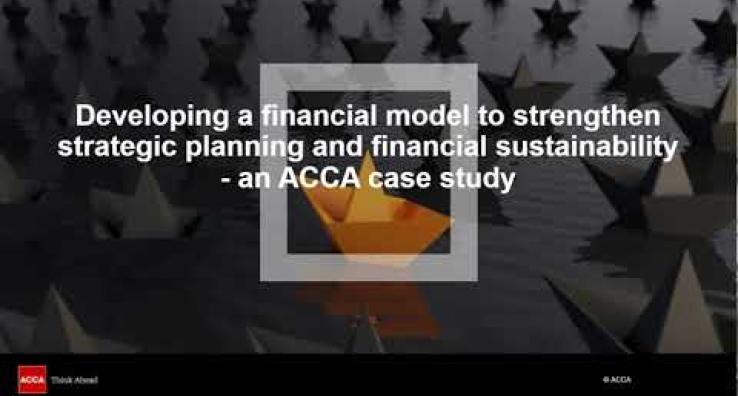
Intro Developing a Financial Model for Strategic Planning & Financial Sustainability - an ACCA Case Study

IFAC CE Forum: PAO Transformation & Evolution Introductory Panel
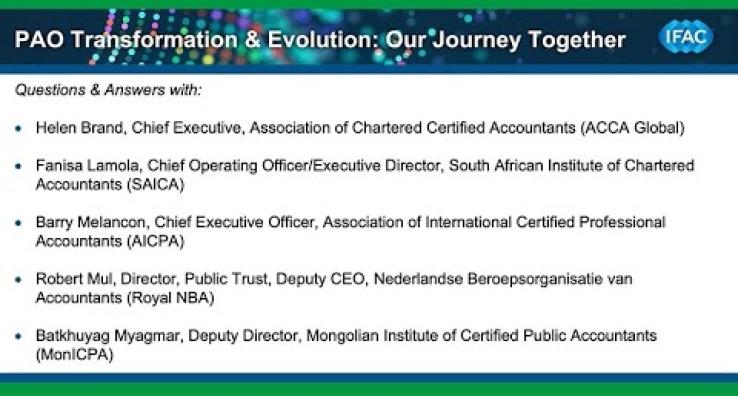
IFAC CE Forum: PAO Transformation & Evolution Question & Answer Session
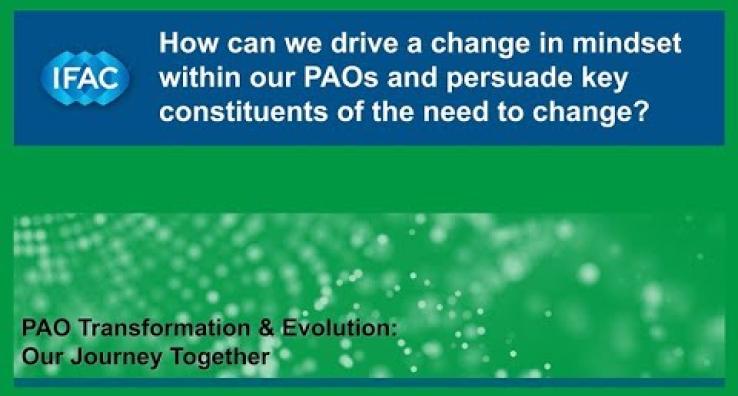
IFAC CE Forum: How can PAOs be drivers of change?
Useful Publications
Resources from Our Network
Call to Action
IFAC’s PAO Development & Advisory Group is a key driver in preparing and curating this content. The Advisory Group is committed to helping IFAC support strong, sustainable PAOs—the most effective, efficient, and sustainable source for advancing the accountancy profession—around the world as part of the IFAC’s development efforts.
Please join us on this journey and support our global community in the public interest. Stronger PAO-to-PAO partnerships benefits all. There are multiple ways to do this:
- We encourage PAO leadership to look within their organizations to determine materials and examples that are relevant and, if appropriately modified and anonymized, could be shared as guidance and resources for other PAOs that face similar issues. Please contact IFAC and the Advisory Group to share a resource.
- If you are an IFAC member organization and interested in providing support and assistance to other professional accountancy organizations in the recovery process, please reach out so that we can share your contact information.
The resiliency of our community is essential and we are all counting on each other!
